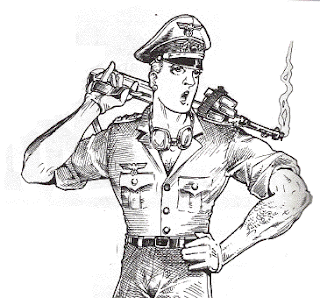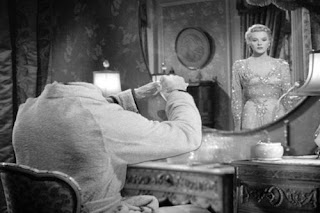Bulldog Drummond Comes Back (1937)
Starring: John Howard, E.E. Clive, Louise Campbell, John Barrymore, Reginald Denny, J. Carroll Naish, and Helen Freeman
Director: Louis King
Rating: Five of Ten Stars
Adventurer Hugh 'Bulldog' Drummond (Howard) is preparing to marry the love of his life, Phyllis Clavering (Campbell), his past comes back to haunt him in a major way. Phyllis is kidnapped by Valdin and Soldanis (Naish and Freeman), a sinister pair of characters with very personal reasons for wanting to torment Drummond. As he is drawn into a deadly game of riddles and clues where Clavering's life is the prize, he calls upon his friend Algy (Denny) and loyal manservant Tenny (Clive) for help, and to keep Scotland Yard's Colonel Nielsen (Barrymore) from accidentially causing Clavering's death.

"Bulldog Drummond Comes Back" is the weakest of the Paramount-produced Bulldog Drummond films, but not through any fault of the actors. Every performer featured is excellent and they play their roles with great style and good humor or deadly menace (depending on what side of the Good/Evil line the characters fall on). The problem here is the script... the situations presented never seems believable or sensible, even when viewed through the screwy lense that captures the world of Hugh Drummond and his pals. As a result, everything seems frivolous and pointless.
Still, the film is great fun to watch. With John Howard replacing Ray Milland in the role of Drummond, the energy and charm of the character is ratcheted up several notches, bringing a rapidfire pace to the film that will be a hallmark of the series for the six.
E.E. Clive also comes fully into his own as Tenny in this film, establishing a scene-stealing dry wit that gives rise to some of this film's funniest moments. He also plays fabulously off the other actors, and he makes a much better on-sceen partner to Howard than he did to Milland.
Louise Campbell, who takes over the role of Phyllis Clavering, is not quite as beautiful as Heather Angel, but, like Clive, she establishes the Phyllis Clavering character as she will appear in the future films--not quite as fully realized as Drummond and Tenny, but the foundation is put in place: As a spunky, self-reliant heroine who can give Dummond and the boys a run for their money. (And she does this while still remaining feminine and mostly proper. As one of the original "spunky heroines", Clavering is an interesting and fun character.)
Barrymore's first outing as Colonel Nielsen is greatly entertaining, although a bit out of character. His persuit of Tenny and Algy in a series of provides as many highpoints to this episode as Tenny and Drummond's banterings.
The rest of the cast performs expertly, as I mentioned above, with Naish being particularly strong in his first turn as a bad guy in the series (he shows up again in "Bulldog Drummond in Africa").
The great performances by the cast, and some snappy dialogue, almost lifts "Bulldog Drummond Comes Back" to the high-end of average... almost but not quite.


 "Desert Peach: Beginnings" reprints Donna Barr's earliest chronicles of the quirky adventures of "Peach," the flamingly gay younger brother of famous WW2 German General Erwin Rommel. Like his brother, "Peach" Rommel is a capable military commander and loyal to Germany, but he is of a far more gentle disposition and is more interested in hanging out with the boys than he is in waging war against the Allies.
"Desert Peach: Beginnings" reprints Donna Barr's earliest chronicles of the quirky adventures of "Peach," the flamingly gay younger brother of famous WW2 German General Erwin Rommel. Like his brother, "Peach" Rommel is a capable military commander and loyal to Germany, but he is of a far more gentle disposition and is more interested in hanging out with the boys than he is in waging war against the Allies. 
